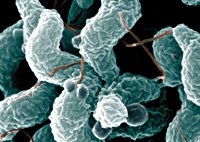The Food Standards Agency (FSA) today published the second set of results from the third year of their survey of campylobacter contamination on fresh chickens at retail. Campylobacter is the biggest cause of food poisoning in Scotland, and research has indicated that 55-75% of human cases in Scotland are associated with chicken. Reducing the levels of campylobacter infection is therefore a priority for Food Standards Scotland (FSS) and we have been working closely with the FSA to promote action by producers and retailers to reduce the levels of contamination in UK-produced chicken.
The results of the survey, based on tests of 1,051 whole fresh chickens sampled during January to March 2017 show that:
· The overall industry average of chickens testing positive for campylobacter within the highest band of contamination (more than 1,000 colony forming units per gram (cfu/g)) was 6.5%. This is down from 9.3% for the same period last year
· The average figure for high-level campylobacter prevalence (>1000cfu/g) among the nine retailers with the highest market share was 5% (compared to 7.8% in January to March 2016).
· The retailers which had significantly lower levels compared to the average among all retailers were M&S, Morrisons and Waitrose at 2.5%, 2.8% and 2.7% respectively.
· The group consisting of a number of smaller retailers and butchers (‘Others’), had a significantly higher level (16.9%) compared to the market average.
· Overall, 48.8% of chicken skin samples tested positive for campylobacter at any level, compared to 50% which tested positive in the same period last year.
FSS Head of Food Protection Science and Surveillance, Dr Jacqui McElhiney, said: “The major UK retailers and poultry producers have all made significant investments and improvements in their processes to reduce campylobacter contamination on chicken. In March 2017 we reported that between August-December 2016, 7% of chickens tested positive for the highest level of contamination, down from 12% for the same period in 2015, and 20% in 2014. Scottish consumers should be encouraged that these latest results show further improvement, indicating that the commitment made by the industry to address this important food safety issue is making a real difference.
“Campylobacter is the most common cause of food poisoning in Scotland, and reducing the levels of contamination in chicken is an important public health measure. Data published by Health Protection Scotland in February 2017 showed a decline of 15.5% in the number of laboratory reports of human cases of campylobacter in Scotland in 2016, compared to 2015. Whilst it is still too early to establish the extent to which we can attribute this decrease to the improvements shown by FSA’s survey results, the trends look encouraging. FSS will continue to work closely with FSA, the industry and public health bodies to promote further action and monitor progress.
“It is very important to reassure consumers that chicken is safe to eat as long as we follow good hygiene practice in the kitchen: that means washing hands and surfaces that come into contact with raw meat, and ensuring chicken is cooked thoroughly to kill any bacteria present.”


